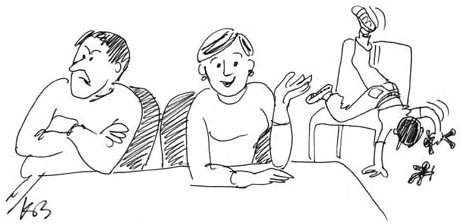| Clinical Consultation | ||
| Inservice |
Getting Started
| Equipment and Preparation |
||
| Set Up Procedures | ||
| Example Forms |
A consultation is often the deliberation of two or more clinicians with respect to the diagnosis or treatment regarding any particular medical case via electronic means. Such means may include, but are not limited to, telephone, facsimile, electronic mail, and two-way interactive video. Videoconsultations usually consist of interactions between less than 3-4 people on each end of the conference.

They are used for collaborative problem solving and may involve sensitive patient information. They are less demanding in regards to equipment needs, but far more demanding with regard to patient confidentiality.
| Clinical videoconsultation with local physician, parent, and child who has ADHD. |
| Psychiatrist Kathleen Myers, MD, holds a clinical videoconsultation with a primary care physician. |
| Dr. Myers holds clinical videoconsultation with parent and physician. |
Telephone conferencing vs. Videoconferencing:
In psychiatry "Body Language" provides important clinical information -- information on whether the participants are intent and involved or apparently "not buying in" is important.
You might hear: "Bill & I really like your ideas for our son and want to have another session with you soon."
What you might see:

Introduction | Types of Videoconferencing | Technical Issues | Getting Started | Examples | Resources | Home